Blue-spotted Hawker - Adversaeschna brevistyla
FAMILY AESHNIDAE

- Matured male, body length 65mm
- This dragonfly is common in Brisbane bushes wherever near fresh water. Males usually found patrolling over bush instead of over water surface. They may be hovering in front of you, checking what you are, if you entered their territory. Females usually fly in a short distance and rest within dense vegetations.
- This is a large dragonfly with bright-blue pattern on black, with two prominent blue stripes on each sides of the thorax. Notice the two large blue spots and the "cat face" pattern on the back near the wings base. The leading edge of all wings are pale orange in colour. Its scientific name was Aeshna brevistyla and changed to Adversaeschna brevistyla recently.
- Male and female look similar except male has the angulated hindwings and female has the round hindwings. They are strong flier, they favours still waters but also found on slowly flowing streams. Females lay eggs into plant tissue or sometimes into soft mud.
This page contains information and pictures about Blue-spotted Hawker Dragonflies that we found in the Brisbane area, Queensland, Australia.
Male
-



- Male, body length 65mm
- In mid-summer 2007, we took the about male photo in Karawatha Forest near the Scrubby Creek late in the afternoon. We think this is the Unicorn Darner. A visitor from Sydney sent us email advised it is a Blue-spotted Hawker. This dragonfly is much more common than the Unicorn Darner and breeds in any permanent body of water, even artificial ones like farm dams and garden pools.



- Young male
- On early September 2008, we saw a few on them flying on a shrubs near near Hakea Track in Karawatha Forest. The area was about 10x10m. There were at least three or more. They are just flying around, seems not protecting their territory nor hunting. There were other dragonflies (Australian Emerald) flying around this small area as well.
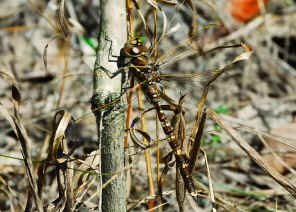


- The Blue-spotted Hawkers usually took a rest after few minutes of flying. They flied on air about 1-2 meter above ground. They usually rested on plants about 0.5 meter above ground. From those pictures we took, they were all immature male with the blue spot still in pale colour.



- On Jan 2011 next to the Bulimba Creek, we found this matured male. The blue colour on the matured male is much richer that the young males and females. The young males were usually found in forest.



- Also found this colourful male in Carbrook Wetland near a small creek on Mar 2011.
Female
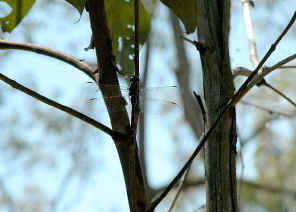
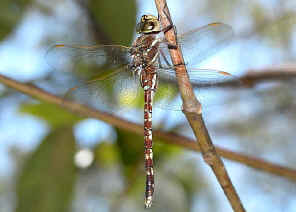
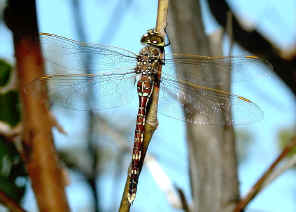
- Female
- We believe we saw this dragonfly many times in the Karawatha Forest, although every time was not so sure. This dragonfly usually hides in the shade on stem as the above left picture. Every time we saw it was when we walked pass it without noticed it, and it flied away fast within a second. We only found it once closely before it noticed us, and we took some better photos.



- We found this female again on Dec 2010 afternoon. It flied in short distance and rest within dense vegetations.
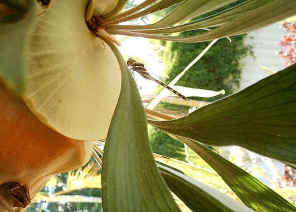
- Photo by Jo McHenry, Brisbane
- Jo McHenry email us the above picture and tell us: "Today we saw the most amazing dragonfly. It was the biggest I've seen with clear zebra striping. It rested on the verandah for about five minutes then took off incredibly fast in a straight line as I turned the plant around for the third time for a better shot."

- The male Blue-spotted Hawker Dragonfly get caught on a spider web.


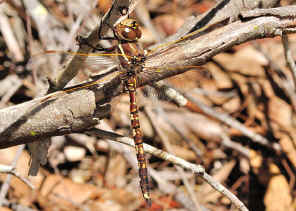
- Reference and Link:
- 1. The Australian Dragonflies - Watson, J.A.L., Theischinger, G., Abbey, H.M. 1991, CSIRO Publications, pp 178.
- 2. A Field Guide to Dragonflies of South East Queensland - Ric Nattrass, 2006, p55.
- 3. The Complete Field Guide to Dragonflies of Australia - CSIRO, GŁnther Theischinger and John Hawking, 2006, p148.
- 4. Aeshna brevistyla - Australian Insect Common Names, CSIRO, 2005.
- 5. Aeshna (Adversaeschna) brevistyla - Australian Biological Resources Study, Department of the Environment and Heritage2005.
- 6. Adversaeschna brevistyla - Blue-spotted Hawker - VICTORIAN DRAGONFLIES.
- 7. Aeshna brevistyla - Blue-spotted Hawker - Deniss Reeves, Austrolestes-Newsletter of Australian Dragonfly Society, #7, 2003.
